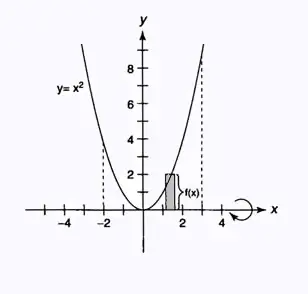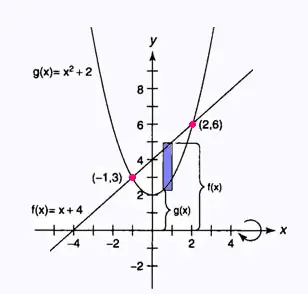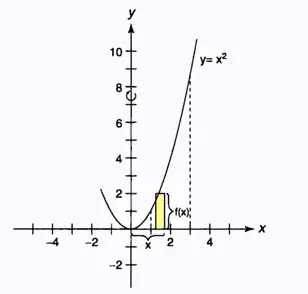Calculus II
Contents
Series
Integrals
Definite integrals
Some primitives
Numerical methods
Exercices
© The scientific sentence. 2010
|
|
Calculus II:
Definite integrals
Volumes of Solids of Revolution
Summmary
Volumes of Solids of Revolution
We use the definite integral to find the volume of a solid.
The solid is obtained by revolving a plane region about a
horizontal or vertical line (or axis).
The used axis is set up to not pass through the region plane.
This type of solid will be made up of the sum of volume
elements.
We use three types of voulume elements: disks, washers, or cylindrical shells
1. Disk method
In this method, the axis of revolution is the boundary of the plane region
and the cross sections are taken perpendicular to the axis of revolution.
The cross section of a disk is a circle with area πr2.
The volume of each disk is its area times its thickness.
If a disk is perpendicular to the x-axis, then its radius is f(x).
If a disk is perpendicular to the y-axis, then its radius
is x = f(y).
The volume (V) of a solid generated by revolving the region bounded by
y = f(x) and the x-axis on the interval [a, b] about the x-axis is
∫ab π[f(x)]2dx
If the region bounded by x = f(y) and the y-axis on [a, b] is revolved about the y-axis,
then its volume (V) is
∫ab π[f(y)]2dy
Exemple 1:

The volume of the solid generated by revolving the region bounded by
y = x2 and the x-axis on [-2,3] about the x-axis.
Because the x-axis is a boundary of the region, you can use the disk method (see Figure 1).
∫-23 π[x2]2dx = 55 π
2. Washer method
In this method the axis of revolution is not a boundary
of the plane region and the cross sections are taken perpendicular
to the axis of revolution.
If R is the radius of the outer disk and r is the radius of the
inner disk, then the area of the washer is π R2 � π r2,
and its volume is its area times its thickness.
As noted for the disk method, if a washer is perpendicular to the x-axis,
then the inner and outer radii are expressed as functions of x.
If a washer is perpendicular to the y-axis, then the radii
should be expressed as functions of y.
The volume (V) of a solid generated by revolving the region
bounded by y = f(x) and y = g(x) on the interval [a, b]
where f(x) ≥ g(x), about the x-axis is:
∫ab π {[f(x)]2 - [g(x)]2}dx
If the region bounded by x = f(y) and x = g(y) on [a, b],
where f(y) ≥ g(y) is revolved about the y-axis, then its volume (V) is
∫ab π {[f(y)]2 - [g(y)]2}dy
Example 2:

The volume of the solid generated by revolving the region
bounded by y = x2 + 2 and y = x + 4 about the x-axis.
The graphs will intersect at (�1,3) and (2,6) with x + 4 = x 2 + 2 on [�1,2] (Figure
Because the x-axis is not a boundary of the region, you can use the washer method, and the volume ( V) of the solid is
∫ ab π{[x + 4]2 - [x2 + 2]2}dx
= 126 π/5
3. Cylindrical shell method
If the cross sections of the solid are taken parallel to
the axis of revolution, then the cylindrical shell method will be
used to find the volume of the solid.
If the cylindrical shell has radius r and height h, then its volume
would be 2πrh times its thickness.
If the axis of revolution is vertical, then the radius and height
are expressed in terms of x. If, however, the axis of revolution is
horizontal, then the radius and height should be expressed in terms of y.
The volume ( V) of a solid generated by revolving the region bounded
by y = f(x) and the x-axis on the interval [ a,b], where f(x) ≥ 0,
about the y-axis is
∫ab 2πxf(x)dx
If the region bounded by x = f(y) and the y-axis on the interval
[ a,b], where f(y) ≥ 0, is revolved about the x-axis, then its volume ( V) is
∫ab 2 πyf(y)dy
Example 3:

The volume of the solid generated by revolving the
region bounded by y = x2 and the x-axis [1,3] about the y-axis.
The axis of revolution is vertical, the integral should be expressed in
terms of x . The radius of the shell is x, and the height of the
shell is f(x) = x2.
The volume (V) of the solid is
∫12 2π x x2dx = 40 π.
|
|